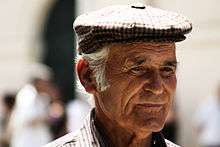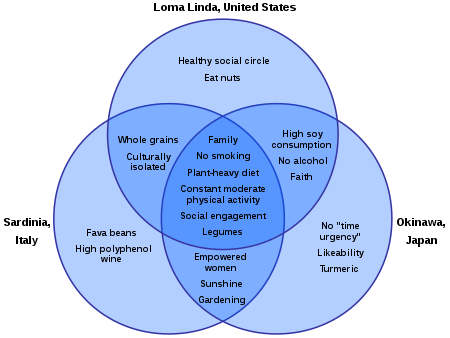Blue Zone
Blue Zones are regions of the world where Dan Buettner claims people live much longer than average. The term first appeared in his November 2005 National Geographic magazine cover story, "The Secrets of a Long Life".[1] Buettner identified five regions as "Blue Zones" (a term he trademarked): Okinawa (Japan); Sardinia (Italy); Nicoya (Costa Rica); Icaria (Greece); and among the Seventh-day Adventists in Loma Linda, California. He offers an explanation, based on data and first hand observations, for why these populations live healthier and longer lives than others.[2]
.svg.png)
The concept grew out of demographic work done by Gianni Pes and Michel Poulain[3] outlined in the Journal of Experimental Gerontology,[4] who identified Sardinia's Nuoro province as the region with the highest concentration of male centenarians. As the two men zeroed in on the cluster of villages with the highest longevity, they drew concentric blue circles on the map and began referring to the area inside the circle as the "Blue Zone". Together with demographers Pes and Poulain, Buettner broadened the term, applying it to validated longevity areas of Okinawa, Japan and among the Seventh-day Adventists in Loma Linda, California. Buettner and Poulain, under the aegis of National Geographic, then identified and validated longevity hotspots in Nicoya, Costa Rica and Icaria, Greece.
Blue Zones

The five regions that are identified in the book The Blue Zones: Lessons for Living Longer from the People Who've Lived the Longest are:[5]
- Sardinia, Italy (particularly Ogliastra, Barbagia of Ollolai, and Barbagia of Seulo): One team of demographers found a hot spot of longevity in mountain villages where a substantial proportion of men reach 100.[5] In particular, a village called Seulo, located in the Barbagia of Seulo, holds the record of 20 centenarians from 1996 to 2016, that confirms it is "the place where people live the longest in the world".[6]
- The islands of Okinawa, Japan: Another team examined a group that is among the longest-lived on Earth.[5]
- Loma Linda, California: Researchers studied a group of Seventh-day Adventists who rank among North America's longest-lived people.[5][7]
- Nicoya Peninsula, Costa Rica: The peninsula was the subject of research on a Quest Network expedition which began on January 29, 2007.[5][8][9]
- Icaria, Greece: An April 2009 study on the island of Icaria uncovered the location with the highest percentage of 90-year-olds on the planet, where nearly 1 out of 3 people make it to their 90s. Furthermore, Icarians "have about 20 percent lower rates of cancer, 50 percent lower rates of heart disease and almost no dementia."[5][10]
Residents of these places produce a high rate of centenarians, suffer a fraction of the diseases that commonly kill people in other parts of the developed world, and enjoy more years of good health.[11]
Characteristics

The people inhabiting Blue Zones share common lifestyle characteristics that contribute to their longevity. The Venn diagram highlights the following six shared characteristics among the people of Okinawa, Sardinia, and Loma Linda Blue Zones:[12] Though not a lifestyle choice, they live as isolated populations with related gene pool.
- Family – put ahead of other concerns
- Less smoking
- Semi-vegetarianism – the majority of food consumed is derived from plants
- Constant moderate physical activity – an inseparable part of life
- Social engagement – people of all ages are socially active and integrated into their communities
- Legumes – commonly consumed
In his book, Buettner provides a list of nine lessons, covering the lifestyle of blue zones people:[13]
- Moderate, regular physical activity.
- Life purpose.
- Stress reduction.
- Moderate caloric intake.
- Plant-based diet.
- Moderate alcohol intake, especially wine.
- Engagement in spirituality or religion.
- Engagement in family life.
- Engagement in social life.
Research
Based on research results in the fields of biogerontology, epigenetics and naturopathy, the term Blue Zones is also used for areas whose native flora grows under special conditions and can effectively counteract the aging process. Such mostly high-altitude areas are located in Nepal, Bhutan, Tibet or China. [14] The Swiss research group Bluezones in cooperation with the Forschungsgruppe Haslberger of the University of Vienna focuses on secondary plant substances from such areas, which could have a use in the area of anti-aging, neurodegenerative diseases and geriatric diseases.[15][16] In 1998, the Swiss group dealt with the eating habits of the population of Yuzurihara, where the inhabitants grew very old with the best quality of life.[17] Longevity regions are also being studied in China.[18] Another research group of the University of California in collaboration with the University of Rome La Sapienza is investigating temporal bluezones in Italy outside Sardinia.[19][20]
Criticism
A 2019 preprint study by Saul Justin Newman identified an alternative correlation between the number of claimed centenarians and a lack of birth certificates in that region, and posits that "fraud and error" could play a primary role in the designation of Blue Zones.[21]
Bibliography
- Buettner, Dan (2012). The Blue Zones, Second Edition: 9 Lessons for Living Longer From the People Who've Lived the Longest. Washington, D.C.: National Geographic. ISBN 978-1426209482. OCLC 777659970.
- Buettner, Dan (2010). Thrive : finding happiness the Blue Zones way. Washington, D.C.: National Geographic. ISBN 978-1426205156. OCLC 651074951.
Further reading
- Poulain, Michel; Herm, Anne; Pes, Gianni. The Blue Zones: areas of exceptional longevity around the world The Blue Zones: areas of exceptional longevity around the world, in: Vienna Yearbook of Population Research, vol. 11, 2013, p. 87-108.
References
- "Longevity, The Secrets of Long Life". National Geographic Magazine. November 2005. Archived from the original on 2017-05-30. Retrieved 2017-04-03.
- "This Adventurer Discovered The Secrets To Long Life — And It Could Save Iowa $16 Billion By 2016". Business Insider. Archived from the original on 27 March 2019. Retrieved 5 November 2018.
- Poulain M.; Pes G.M.; Grasland C.; Carru C.; Ferucci L.; Baggio G.; Franceschi C.; Deiana L. (2004). "Identification of a Geographic Area Characterized by Extreme Longevity in the Sardinia Island: the AKEA study" (PDF). Experimental Gerontology. 39 (9): 1423–1429. doi:10.1016/j.exger.2004.06.016. PMID 15489066. Archived (PDF) from the original on 2020-01-07. Retrieved 2019-09-17.
- Poulain, Michel; Pes, Giovanni Mario; Grasland, Claude; Carru, Ciriaco; Ferrucci, Luigi; Baggio, Giovannella; Franceschi, Claudio; Deiana, Luca (2004-09-01). "Identification of a geographic area characterized by extreme longevity in the Sardinia island: the AKEA study" (PDF). Experimental Gerontology. 39 (9): 1423–1429. doi:10.1016/j.exger.2004.06.016. PMID 15489066. Archived (PDF) from the original on 2020-01-07. Retrieved 2019-09-17.
- Buettner, Dan (21 April 2009) [2008]. "Contents". The Blue Zones: Lessons for Living Longer From the People Who've Lived the Longest (First Paperback ed.). Washington, D.C.: National Geographic. p. vii. ISBN 978-1-4262-0400-5. OCLC 246886564. Retrieved 15 September 2009.
- "Seulo, il paese più longevo del mondo Soprannomi e segreti del paese dei record - Cronaca". L'Unione Sarda.it. 2016-04-03. Archived from the original on 2016-10-20. Retrieved 2016-11-27.
- Anderson Cooper, Gary Tuchman (November 16, 2005). "Transcripts on Living Longer". CNN. Archived from the original on September 8, 2006. Retrieved 2006-08-25. See CNN excerpt Archived 2011-03-17 at the Wayback Machine on YouTube.
- "Nicoya, Costa Rica". BlueZones.com. Archived from the original on 2011-03-15. Retrieved 2011-03-04.
- Dan Buettner (2007-02-02). "Report from the 'Blue Zone': Why Do People Live Long in Costa Rica?". ABC News. Archived from the original on 2011-05-11. Retrieved 2011-03-04.
- The Island Where People Live Longer' Archived 2017-10-10 at the Wayback Machine, NPR: Weekend Edition Saturday, May 2, 2009.
- Buettner, Dan: "The Secrets of Long Life.", page 9. National Geographic, November 2005.
- Power 9™ » Blue Zones – Live Longer, Better Archived 2011-12-29 at the Wayback Machine: "Blue Zones – Live Longer, Better", Quest Network, 2006.
- Buettner, Dan (2012-11-06). The Blue Zones, Second Edition: 9 Lessons for Living Longer From the People Who've Lived the Longest. National Geographic Books. ISBN 9781426209499. Archived from the original on 2016-03-28. Retrieved 2015-09-22.
- "Why People in "Blue Zones" Live Longer Than the Rest of the World". Healthline. Archived from the original on 2019-09-04. Retrieved 2019-09-04.
- "Blue Zones". www.bluezones.ch. Archived from the original on 2019-06-03. Retrieved 2019-09-04.
- Wiedemann, Dominik; Haberl, Thomas; Riebandt, Julia; Simon, Paul; Laufer, Günther; Zimpfer, Daniel (2014). "Ventricular Assist Devices – Evolution of Surgical Heart Failure Treatment". European Cardiology Review. 9 (1): 54–58. doi:10.15420/ecr.2014.9.1.54. ISSN 1758-3756. PMC 6159437. PMID 30310486.
- KOMORI, TOYOSUKE (1984). "Looking back of studies on the long life village "Yuzurihara". - Especially upon the relation-ship between long life and bacterial situation in intestine". Japanese Journal of AMHTS. 11 (3): 199–209. doi:10.7143/jhep1975.11.199. ISSN 1884-4081.
- Zhao, Zhongwei (2008), "The Challenge to Healthy Longevity: Inequality in Health Care and Mortality in China", Healthy Longevity in China, Demographic Methods and Population Analysis, 20, Springer Netherlands, pp. 269–287, doi:10.1007/978-1-4020-6752-5_16, ISBN 9781402067518
- Schaeffel, Frank (1999). "Das wachsende Auge - ein optisches System mit Autofokus". Biologie in Unserer Zeit. 29 (4): 238–246. doi:10.1002/biuz.960290407. ISSN 0045-205X.
- Aversa, Antonio; Bruzziches, Roberto; Francomano, Davide; Greco, Emanuela A; Migliaccio, Silvia; Lenzi, Andrea (2010). "The Role of Steroids in Endothelial Function in the Ageing Male". European Endocrinology. 7 (2): 115. doi:10.17925/ee.2011.07.02.115. ISSN 1758-3772.
- Newman, Saul Justin (2019-07-16). "Supercentenarians and the oldest-old are concentrated into regions with no birth certificates and short lifespans". bioRxiv: 704080. doi:10.1101/704080. Archived from the original on 2019-08-07. Retrieved 2019-08-07.